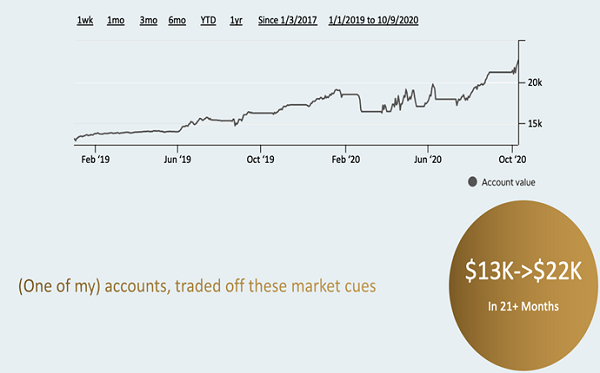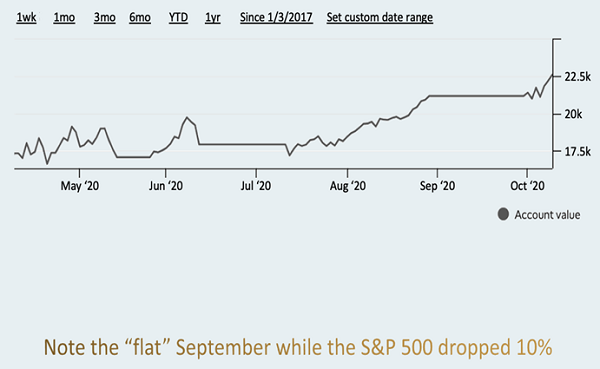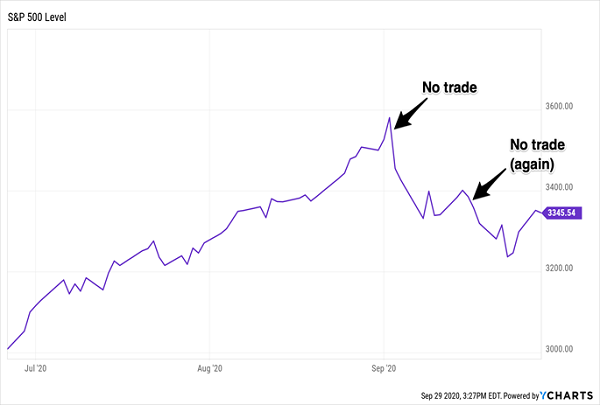Last week, on our dividend trading webcast, several readers asked me how I manage my own money. Well, it’s a bit different from the “buy and hold” (or hope!) strategies employed by most income investors. Here’s why…
I don’t like holding full positions during downturns. When the market looks like it’s about to roll over, or when it actually begins to roll over, I (personally) head for the sidelines.
And when the pullback is over, I flip my cash back into the market. It’s that simple.
Following this strategy, there have really only been four “trades” to make all year. In January and February, you wanted to be in the market. March, you’d have wanted out.
Then April through August, in. September, back out. And now, in October, we want “back in”:
4 Simple Trades for 2020

I’ve been “swing trading” my accounts in some capacity or another since 2002. In the mid ‘00s, I traded sugar, corn, cocoa and other agricultural futures. And let me tell you, if you trade commodities for any length of time, you’ll develop some aversion to long-term trades! It’s possible to make boatloads trading the food supply, but you’ve got to be nimble.
In 2008, anyone who wasn’t “nimble enough” to get out and stay out got crushed. That was me, watching a $154,000 stake I’d grown from $2,000 whittle away.
(Luckily, I did invest some of the capital into my first company—so while the money is gone, it is not forgotten! My startup forced me to diversify, and the sugar cash did help me leave Corporate America for good… which gave me time to continue my pursuit of this ultimate trading strategy.)
Fast-forward to 2019, and I turned my attention to a neglected rollover IRA account. Yes, even those of us who live in the markets get distracted by our day jobs! I had about $13,000 in it, and decided it was time to finally get serious and do something with the cash. I began trading it using my new system and added $9,000 in profits over the next 21+ months:
My Forgotten IRA Gets “Swing Trading” Love

I was particularly proud of a “flat September” where the S&P 500 corrected by 10% but my account traded sideways (thanks to a cue from my system that a pullback was coming):
The Stock Market is Great When We Sidestep Pullbacks

If you’re a Dividend Swing Trader subscriber, you received a note from me at the beginning of September that said “sit on your hands.” We stayed off the hopeless “pullback treadmill” all month long, punting on two (and later, three) dividend trades we would normally make:
A Fortunately Boring September for DST

When the pullback appeared to be in the rearview mirror, we were able to pick up some high quality closed-end funds (CEFs) that paid nice dividends and traded at big discounts to their net asset values (NAVs).
A DST subscriber wrote in and asked:
“Brett, why do I ever have to sell these CEFs? Can’t I just buy them and hold them, like we do in Contrarian Income Report?”
Of course, you are welcome to do whatever you’d like with our income analysis. But, here’s my case for market timing.
If we’d bought the same CEFs on September 1, we’d have watched them get crushed all month. Why take losses if we believe we can avoid them?
October was a better entry point. We banked more dividend for our dollar and secured a better discount, too. Now we have the opportunity to earn 20% total returns within the next year from these funds.
And when the next pullback appears? Rather than give back some gains, we’ll issue an alert in DST saying that it is time to book our profits, wait out the storm clouds and prepare our dry powder for the next trades.
Remember, pullbacks tend to be lightning-fast these days. The March crash found a bottom before the end of the month, and most of the September damage happened in a few weeks. Why not be in cash and safe (low beta) dividend stocks when the seas are rocky?
There’s a time and a place to make money on anything. Buying and holding works, but it also places a “ceiling” on returns because we must accept the bear with the bull. But by trading these same types of high-quality dividend stocks we love—and narrowing our holding period from years to months—we can reduce the pain we receive from pullbacks.
How exactly can we achieve this? Let me explain my updated Dividend Swing Trader strategy to you. If you glanced at it previously, this is a great time to revisit, because:
- I’ve continued to invest in, work on and improve the strategy.
- And, (as I write) we still have a few openings for new subscribers. The seats are unlikely to last, however!
We are wrapping up our risk-free trial offer as we speak. And between you and me, its price may never be this low ever again. We cap our subscriber count for DST so that we can take advantage of opportunities in smaller stocks and funds (which is where many of the fun inefficiencies can be found, even in 2020)
If you are even remotely interested in this strategy, I’d grab your risk-free trial right now. My publisher had originally planned to leave the offer open through the election, but I do worry that the popularity of DST is going to force them to reduce that timeframe. As I write, the offer is still open, and you can take advantage of it (and set yourself up for 20% returns from secure dividends) right here!
